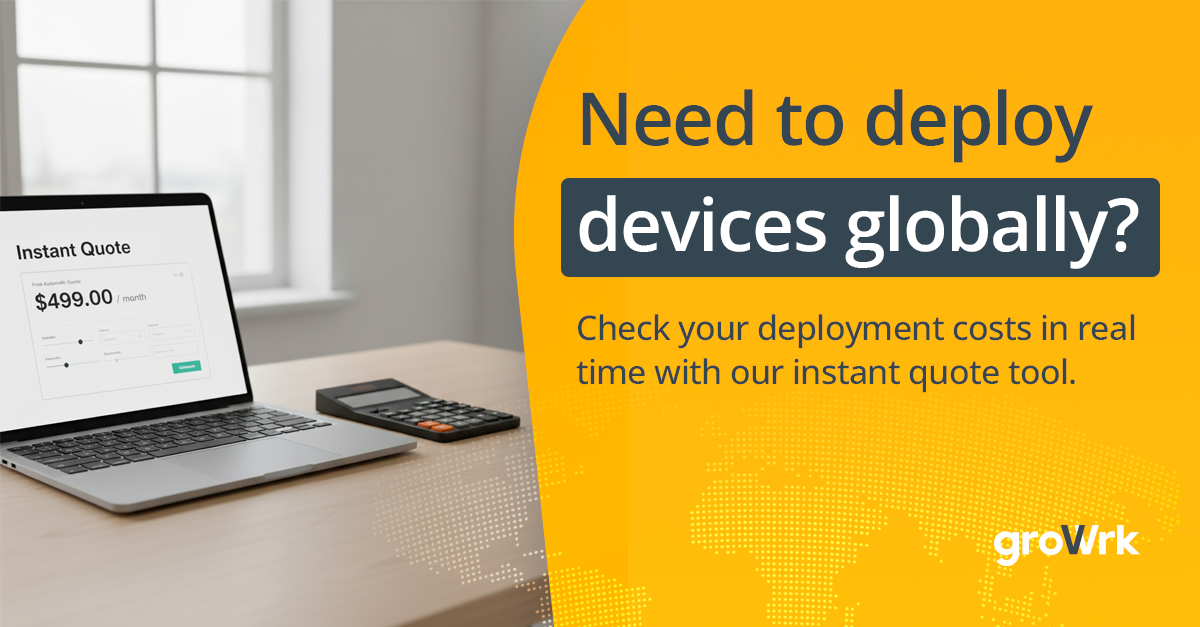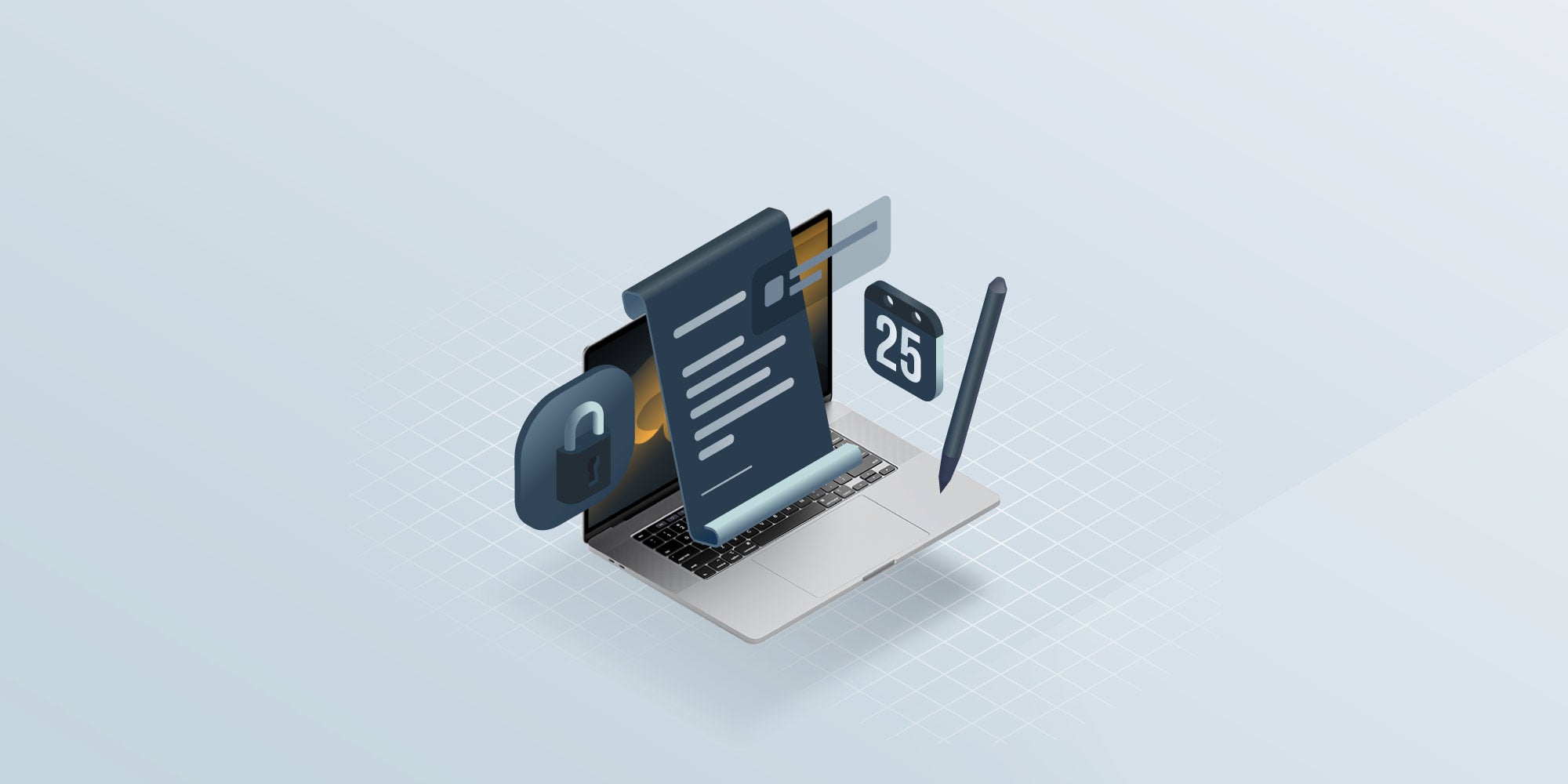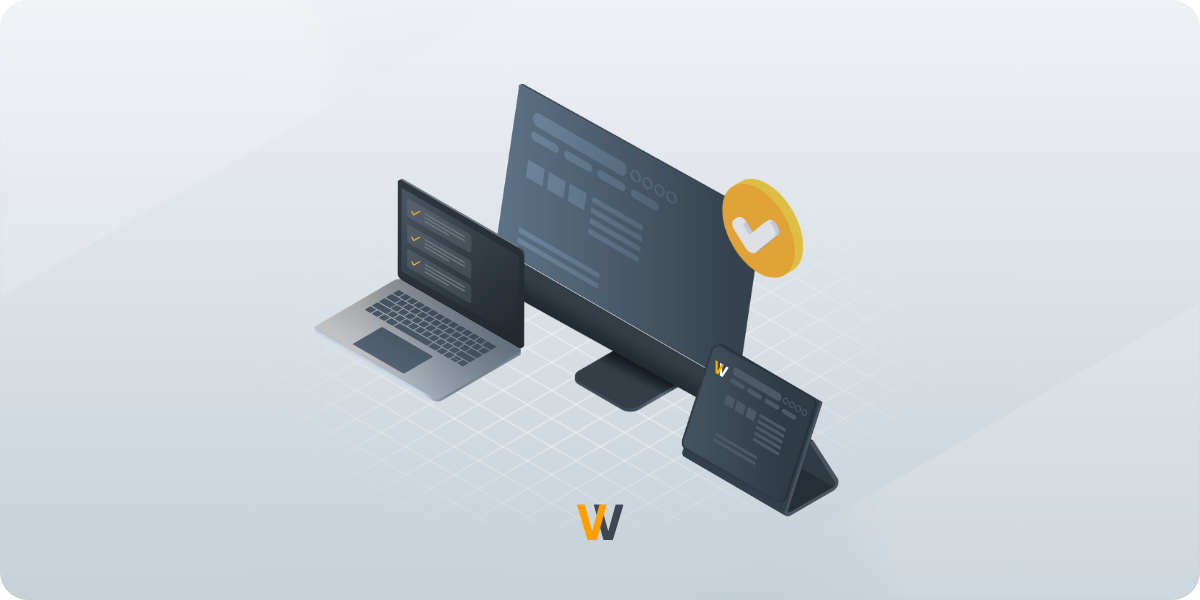Top 9 IT Vendor Management Best Practices for 2025
 GroWrk Team
GroWrk Team
Want your IT vendor partnerships to go from uncertain to seamless? Use these tips to revamp your approach to managing vendors the smart way. This guide provides simple steps to select top-notch vendors, manage contracts, and utilize tools to save time and energy. Explore these ideas to sharpen your IT vendor management game!
Key takeaways
- Managing IT vendors in 2025 plays a big role in improving the way companies handle procurement, reducing risks, and making vendor relationships more valuable in today's unpredictable global economy.
- Companies should use AI to pick vendors, conduct due diligence with a focus on ESG principles, and improve contract management practices. These steps help to follow regulations, protect against cybersecurity threats, and support sustainable business operations.
- Businesses need to keep up with changing tech and rules in 2025 by using predictive analytics, automated reports, and feedback systems. These tools help adjust vendor management strategies as needed.
Understanding IT vendor management
_7_11zon.jpg?width=600&height=300&name=it%20vendor%20management%20(1)_7_11zon.jpg)
IT vendor management is the structured process of overseeing relationships with technology providers, from hardware suppliers and SaaS vendors to cloud and IT services firms. The aim is to control costs, reduce risks, and maximize value from vendor partnerships.
In 2025, effective vendor management means more than just procurement; it requires balancing quality, sustainability, and resilience against a backdrop of global supply chain disruptions and evolving regulations.
Key elements include:
-
Cost and risk control: Preventing overspend and ensuring vendors meet compliance requirements.
-
Sustainability integration: Embedding ESG factors into selection and performance reviews.
-
Strategic alignment: Treating vendor management as a business-critical function, not just an operational task.
-
Future-ready skills: Combining technical expertise, digital literacy, and strong collaboration capabilities.
With AI-driven planning and clearly defined accountability (via vendor management committees and documented roles), businesses can turn vendor management into a strategic enabler for growth and resilience.
Key components of IT vendor management
Vendor management includes several activities:
-
Vendor selection
-
Contract negotiation
-
Performance measurement
-
Relationship management
-
Vendor relationship management
-
Vendor management strategy
Selecting vendors and negotiating contracts are key elements. Monitoring performance and ensuring compliance are crucial. To evaluate potential vendors effectively, organizations should set specific and measurable goals.
Compliance is vital to maintaining the integrity and performance of vendor relationships. Key aspects of vendor management involve selecting the right vendors, negotiating suitable contracts, and monitoring performance for compliance.
Get an instant quote
Benefits of IT vendor management
A structured vendor management program creates tangible value across cost, compliance, service quality, and innovation. When supported by modern tools, businesses can leverage vendor relationships as strategic growth levers.
-
Cost savings: Smarter negotiations, consolidated services, and continuous performance reviews reduce spend and eliminate waste.
-
Improved service quality: Clear SLAs and vendor management systems ensure consistent delivery, fewer disruptions, and higher customer satisfaction.
-
Risk mitigation: Ongoing monitoring of vendor performance and security controls helps identify risks early, from compliance gaps to potential service failures.
-
Stronger relationships: Transparency and collaboration build trust, resulting in more strategic partnerships and better communication.
-
Enhanced data security: Strict protocols and compliance standards reduce breach risk and protect sensitive information.
-
Streamlined contract management: Automation reduces administrative overhead, ensures renewal deadlines aren’t missed, and keeps obligations clear.
-
Performance evaluation: Tracking KPIs and metrics enables continuous improvement and accountability.
-
Operational efficiency: Automating workflows and centralizing vendor data cuts manual errors and frees up resources.
-
Access to innovation: Partnerships provide exposure to specialized expertise, new solutions, and emerging technologies.
-
Regulatory compliance: Embedding compliance checks into processes minimizes legal risk and safeguards reputation.
By applying these practices, organizations can enhance their financial performance, strengthen resilience, and align vendor relationships with their long-term business objectives.
Common vendor management challenges
Choosing the right vendor is a significant challenge. A poor decision can disrupt operations and weaken compliance efforts. Learn how global IT procurement strategies can elevate your vendor relationships. Thorough research and evaluation of multiple options are necessary.
Organizations must assess capabilities, reliability, ESG commitments, cybersecurity posture, and financial stability. Managing multiple vendors across different IT functions can introduce coordination issues, inefficiencies, and increased costs.
1. Know how to select the best IT vendor
_5_11zon.jpg?width=600&height=300&name=it%20vendor%20management%20(3)_5_11zon.jpg)
Vendor selection sets the tone for the entire partnership. The right choice improves operations, ensures compliance, and supports long-term business goals, while the wrong one can lead to delays, poor quality, or regulatory issues.
Steps to strengthen vendor selection in 2025:
-
Define goals upfront: Start with clear objectives for cost efficiency, service quality, and long-term value. A detailed procurement plan translates these goals into actionable steps.
-
Form a purchasing committee: Include vendor managers, finance teams, and key stakeholders to ensure alignment with strategic priorities.
-
Evaluate beyond cost: Assess candidates for reliability, ESG performance, cybersecurity posture, and financial stability, not just pricing.
-
Leverage smart platforms: Modern vendors increasingly offer automation-driven services that simplify procurement and lifecycle management. For example, platforms like GroWrk support the entire device lifecycle from procurement to secure disposition in one dashboard.
By focusing on structured evaluation and aligning vendor policies with business strategy, organizations can build vendor partnerships that deliver consistent value and resilience.
Conduct thorough due diligence
Due diligence ensures a vendor is not just capable but also trustworthy and resilient. This means evaluating both technical and non-technical factors before making a commitment.
What to review:
-
Work history and client base: Demonstrates reliability and track record.
-
ESG performance: Confirms alignment with sustainability and ethical standards.
-
Cybersecurity credentials: Look for certifications such as SOC 2, ISO 27001, or NIST-aligned practices.
-
Financial health: Review credit ratings, financial statements, and stability to avoid mid-contract failures.
By matching these checks against defined business needs and technical goals, companies can reduce vendor risk and ensure partnerships that are sustainable and compliant.
Evaluate vendor proposals
Once potential vendors are shortlisted, proposals must be reviewed against clear, predefined criteria to ensure alignment with business needs.
Key factors to consider:
-
Trustworthiness and track record: Proven delivery capability matters more than promises.
-
Financial stability: Confirm vendors can meet long-term obligations.
-
ESG commitments: Evaluate environmental and social responsibility as part of the scoring process.
-
Security posture: Ensure strong data protection and compliance practices are in place.
AI-powered scoring systems are increasingly used in 2025 to standardize evaluation, reduce bias, and surface the vendors best positioned for long-term, strategic partnerships.
2. Prioritize effective contract management
Strong contracts are the backbone of successful vendor partnerships. Effective contract management means going beyond pricing to include security, sustainability, and performance accountability.
Key elements to include:
-
Comprehensive terms: Pricing, payment schedules, cybersecurity standards, ESG requirements, and performance indicators.
-
Service level agreements (SLAs): Define clear benchmarks for service quality, compliance, and penalties for breaches.
-
Statement of Work (SOW): Specify scope, deliverables, timelines, and AI usage clauses to avoid ambiguity.
Modern vendor contracts should be living documents, regularly reviewed and updated to stay aligned with business goals, new regulations, and emerging risks. A well-structured agreement not only reduces risk but also strengthens collaboration and service excellence.
Define clear expectations
Clarity in agreements is the foundation of vendor accountability. Contracts should explicitly outline:
-
Deliverables and timelines: What will be delivered, when, and by whom
-
Roles and responsibilities: Who owns each part of the process
-
ESG and compliance disclosures: Sustainability and regulatory obligations tied to performance
Setting measurable goals upfront prevents misunderstandings, reduces conflict, and makes it easier to evaluate vendor performance against agreed benchmarks.
Use automation tools
Manual contract reviews are time-consuming and prone to error. Businesses are turning to automation to keep agreements aligned with evolving goals, regulations, and AI governance requirements.
Automation enables:
-
Faster reviews: AI-powered tools analyze contracts for risks, compliance gaps, and missed obligations.
-
Smarter searches & tracking: Centralized platforms make agreements easy to access, search, and monitor.
-
Risk reduction: Blockchain-based smart contracts lower oversight errors and enforce compliance automatically.
By integrating automation into contract management, organizations can save time, improve accuracy, and ensure contracts remain current and defensible.
3. Invest in performance monitoring and evaluation
_1_11zon.jpg?width=600&height=300&name=it%20vendor%20management%20(7)_1_11zon.jpg)
A vendor relationship is only as strong as its performance tracking. Organizations are utilizing data-driven monitoring systems to ensure that vendors deliver on their commitments and comply with established standards.
Best practices:
-
Set clear KPIs: Define measurable goals aligned with business objectives, such as cost savings, uptime, or ESG benchmarks.
-
Leverage technology: A Vendor Management System (VMS) provides real-time dashboards, automated reporting, and audit-ready compliance data.
-
Conduct regular reviews: Performance reviews with vendors create accountability, surface issues early, and drive continuous improvement.
-
Analyze costs vs. value: Tracking expenses against outcomes ensures partnerships remain efficient and profitable.
By combining KPIs, automated monitoring, and structured feedback, companies can transform vendor management into a cycle of ongoing improvement.
Establish Key Performance Indicators (KPIs)
KPIs translate vendor expectations into measurable results. They go beyond simple delivery metrics to include predictive and compliance-focused indicators.
How to approach KPIs:
-
Define success upfront: Decide what “good performance” looks like, cost efficiency, uptime, ESG benchmarks, or compliance metrics.
-
Use AI-driven monitoring: Predictive dashboards flag risks in real time and highlight trends before they become problems.
-
Review regularly: KPIs should evolve with changing business goals and regulations.
With clear, adaptable KPIs supported by AI tools, organizations can evaluate vendors objectively and ensure contracts deliver both value and compliance.
Regular performance reviews
Consistent performance reviews keep vendors accountable and aligned with business goals. They:
-
Validate delivery: Confirm vendors are meeting agreed-upon obligations and SLAs.
-
Identify gaps: Highlight underperformance early so corrective action can be taken.
-
Promote collaboration: Provide space for open feedback, reinforcing commitment to shared success.
Regular reviews transform vendor management from a reactive process into a proactive partnership model that drives continuous improvement.
4. Build strong vendor relationships
_2_11zon.jpg?width=600&height=300&name=it%20vendor%20management%20(6)_2_11zon.jpg)
Strong vendor relationships turn suppliers into strategic partners who contribute directly to business success. Trust and transparency are the foundation: treating vendors as collaborators with shared objectives leads to better communication, innovation, and outcomes.
Best practices for relationship building:
-
Establish transparency early: Clear, respectful negotiations set the tone for trust.
-
Maintain regular communication: Frequent check-ins and structured updates keep expectations aligned.
-
Encourage feedback: Collect input from vendors, stakeholders, and employees who work directly with suppliers to uncover opportunities for improvement.
-
Foster collaboration: Joint problem-solving strengthens partnerships and builds resilience.
When managed this way, vendor relationships evolve from transactional contracts into long-term strategic alliances.
Foster open communication
Open communication is the cornerstone of effective vendor partnerships. It ensures alignment, prevents misunderstandings, and strengthens trust.
How to keep communication clear and productive:
-
Set expectations early: Define needs and goals at the start of the partnership.
-
Use technology: Cloud-based platforms and AI-enabled tools streamline updates, shorten response times, and maintain accountability through records.
-
Review KPIs together: Regular discussions around performance metrics keep both sides working toward shared goals.
By combining transparency with the right IT tools, businesses create vendor relationships that are responsive, accountable, and resilient.
Collaboration and partnership
True vendor success comes from treating suppliers as partners, not just contractors. A partnership mindset fosters trust, innovation, and shared accountability.
Best practices:
-
Promote transparency: Clear communication builds mutual respect.
-
Ensure mutual benefit: Agreements should create value for both parties, strengthening long-term cooperation.
-
Leverage technology: AI-powered tools and shared platforms simplify collaboration and spark innovation.
When vendors are engaged as partners, organizations gain more than services, they gain strategic allies who help drive performance and innovation.
5. Understand risk management in IT vendor management
Third-party vendors can be a source of opportunity or a serious risk. Effective vendor management reduces threats such as data breaches, service disruptions, and compliance failures.
Key areas of vendor risk:
-
Data security: Breaches through vendor systems can expose sensitive information.
-
Regulatory compliance: Vendors must meet evolving requirements, from GDPR and HIPAA to new AI governance standards and ISO certifications.
-
Financial stability: A financially weak vendor may fail mid-contract, disrupting operations.
-
Operational resilience: Over-reliance on one vendor increases vulnerability to outages or political and supply chain disruptions.
Best practices for mitigation:
-
Validate vendor certifications (e.g., SOC 2, ISO 27001, R2v3) and require documented compliance.
-
Conduct financial and cybersecurity assessments during due diligence.
-
Diversify vendors or establish backups to reduce single-vendor dependency.
-
Centralize agreements and oversight to maintain visibility and control.
Managing risk proactively ensures vendor partnerships remain secure, compliant, and resilient even as regulations and technologies evolve.
Conduct risk assessments
Risk assessments provide a structure for identifying and mitigating vendor-related threats before they escalate. This process blends traditional reviews with AI-enabled monitoring.
What to include in a vendor risk assessment:
-
Experience and track record: Proven ability to deliver consistently.
-
Compliance history: Past adherence to regulations and certifications.
-
ESG commitments: Alignment with sustainability and ethical standards.
-
Financial health: Stability to meet long-term obligations.
Tools and methods:
-
AI-powered monitoring for real-time alerts on compliance or security risks.
-
Vendor surveys and compliance records for documentation.
-
Kraljic matrix to segment vendors by profit impact and supply risk.
A clear and repeatable risk assessment framework ensures that vendor partnerships remain secure, reliable, and strategically aligned.
Develop contingency plans
Even the best vendors can face disruptions, from cyberattacks to political instability. Contingency planning ensures your business can continue operating when those risks materialize.
Best practices for contingency planning:
-
Identify critical functions: Pinpoint the services and vendors most essential to operations.
-
Create backup strategies: Establish alternate suppliers or redundant systems to minimize downtime.
-
Document clear protocols: Define responsibilities, escalation paths, and recovery timelines.
-
Test and update regularly: Run simulations and refresh plans as regulations, vendors, and technologies evolve.
With contingency plans in place, organizations can maintain business continuity and customer confidence even in the event of unexpected vendor failures.
6. Leverage technology in vendor management
_3_11zon.jpg?width=600&height=300&name=it%20vendor%20management%20(5)_3_11zon.jpg)
Technology is now the backbone of vendor management. Centralized, AI-enabled platforms help organizations manage complex ecosystems of IT suppliers, contracts, and compliance requirements.
Key advantages of technology in vendor management:
-
Centralization: Procurement and vendor data in one platform improves visibility and collaboration.
-
Automation: Contract tracking, renewals, and compliance checks run faster and with fewer errors.
-
Cloud collaboration: Teams share updates instantly across geographies, reducing miscommunication.
-
AI insights: Predictive analytics flag risks, forecast costs, and highlight performance trends.
-
Streamlined onboarding: Automated workflows accelerate vendor setup and improve cooperation.
By embedding digital tools into procurement, organizations transform vendor management from a manual process into a scalable, data-driven system.
Implement vendor management software
Modern vendor management software consolidates all vendor activity into a single, unified source of truth. In 2025, advanced platforms combine:
-
Onboarding workflows to standardize and accelerate vendor setup
-
Contract tracking with renewal alerts and compliance checks
-
ESG monitoring to measure sustainability and ethical performance
-
Dashboards that visualize performance, risk, and spend in real time
-
AI-powered communication for faster updates and automated reminders
By consolidating agreements, performance metrics, and compliance data, these platforms reduce manual errors, simplify reporting, and give IT and procurement leaders end-to-end visibility.
Utilize automated procurement systems
Automated procurement systems streamline the entire purchasing cycle, from contract discussions to ordering, delivery, and payments. By reducing manual tasks, they improve accuracy, cut delays, and enhance visibility into spend.
Benefits of automation in procurement:
-
Fewer errors: Automated workflows reduce mistakes in orders and invoices.
-
Efficiency: Speeds up approvals, deliveries, and payments.
-
Transparency: Centralized data makes vendor costs easier to track and optimize.
-
Scalability: Supports global operations by standardizing procurement across regions.
GroWrk extends these capabilities further by enabling businesses to purchase, deploy, and recover devices in over 150 countries from a single dashboard.
7. Ensure compliance and data security
_6_11zon.jpg?width=600&height=300&name=it%20vendor%20management%20(2)_6_11zon.jpg)
Third-party vendors often create the weakest link in cybersecurity and compliance. A strong vendor management program mitigates these risks by establishing clear standards and maintaining continuous oversight.
Best practices for compliance and data security:
-
Align contracts with regulations: Ensure vendor agreements reflect current requirements, from GDPR and HIPAA to emerging AI governance rules.
-
Validate security practices: Review vendors’ data handling, encryption, and access controls against frameworks like ISO 27001 or SOC 2.
-
Monitor financial and operational health: Confirm vendors can maintain compliance without disruption.
-
Track invoices and costs: Ongoing invoice reviews help detect hidden charges and prevent financial leakage.
By holding vendors to verifiable compliance and security benchmarks, businesses can reduce exposure, protect sensitive data, and safeguard their reputation.
Monitor vendor compliance
Compliance isn’t static; regulations and standards are constantly evolving. Businesses must actively track vendor adherence to avoid penalties and reputational risk.
How to monitor effectively:
-
Automated tracking: Use AI-driven systems that flag compliance issues in real time.
-
Regular reviews: Conduct scheduled audits of vendor processes and certifications.
-
Enforce accountability: Apply penalties for non-compliance and document corrective actions.
With proactive monitoring, organizations can ensure that vendors stay aligned with laws, company policies, and industry standards, thereby protecting both operations and their reputation.
Implement data security measures
Protecting sensitive information is central to maintaining customer trust and meeting regulatory requirements. Vendor contracts should mandate strong, modern security controls.
Core measures to require from vendors:
-
Encryption: Safeguards data in transit and at rest.
-
Access controls & Zero Trust: Limit exposure by restricting access to only what’s necessary.
-
Routine audits: Identify vulnerabilities and confirm compliance.
-
Training & awareness: Reduce human error through continuous education.
By continuously improving these safeguards, organizations ensure vendors remain resilient against evolving cyber threats.
8. Focus on cost management and optimization
Unclear or hidden costs are one of the biggest challenges in vendor management. Without visibility, companies risk overspending and missing opportunities to optimize budgets.
Best practices for cost management:
-
Monitor expenses continuously: Use spend management tools to track vendor costs in real time.
-
Negotiate strategically: Consolidating services and renegotiating contracts helps unlock savings.
-
Audit regularly: Routine audits catch inefficiencies, overbilling, or duplicate charges.
-
Balance cost with ESG goals: Ensure cost reductions don’t compromise sustainability or compliance commitments.
By pairing financial oversight with strategic negotiation, organizations can achieve long-term cost efficiency and stronger vendor relationships.
Transparent pricing models
Transparency in pricing eliminates hidden fees, making vendor relationships easier to manage. Clear pricing models:
-
Simplify budgeting by reducing uncertainty around costs
-
Prevent disputes by setting expectations upfront
-
Strengthen trust between organizations and vendors
When vendors provide straightforward and predictable pricing, businesses gain better control over expenses and can improve their long-term planning.
Identify cost-saving opportunities
Modern spend management tools make it easier to uncover hidden savings in vendor relationships.
Ways to identify savings:
-
Automated expense tracking: Provides real-time visibility into where money is going.
-
AI-powered cost comparisons: Highlight inefficiencies by benchmarking vendor costs against industry or internal standards.
-
Performance-based reviews: Link vendor payments to KPIs to ensure spend matches value delivered.
With these approaches, companies can reduce waste, optimize budgets, and ensure vendor spending supports both profitability and sustainability goals.
9. Continuous improvement of your vendor management
_4_11zon.jpg?width=600&height=300&name=it%20vendor%20management%20(4)_4_11zon.jpg)
Vendor management must evolve in response to shifting markets, technologies, and regulations. A culture of continuous improvement helps organizations stay agile and extract greater value over time.
How to drive continuous improvement:
-
Audit contracts regularly: Identify inefficiencies, hidden costs, or outdated terms.
-
Refine cost strategies: Use insights from reviews to strengthen financial performance.
-
Adapt to change: Update processes in response to new compliance rules, security risks, or technology advances.
With ongoing refinement, vendor management becomes a dynamic process that consistently delivers savings, compliance, and stronger partnerships.
Regular audits and assessments
Audits provide the structure to identify gaps, ensure compliance, and strengthen vendor partnerships.
Best practices:
-
Evaluate key areas: Review compliance, cybersecurity, ESG performance, and cost efficiency.
-
Use consistent criteria: Apply standardized benchmarks so reviews are objective and comparable.
-
Report findings: Share results transparently to keep vendors and internal teams accountable.
By embedding audits into vendor management, organizations create a cycle of accountability and improvement that keeps strategies aligned with business goals.
Feedback and adaptation
Feedback transforms vendor management into a two-way process that enhances outcomes for both parties.
How to build effective feedback loops:
-
Collect input regularly: Gather feedback from vendors and internal teams after reviews or major projects.
-
Act on insights: Address issues quickly to maintain trust and momentum.
-
Use AI analytics: Identify patterns across feedback data to refine strategies and align vendor goals with business needs.
With continuous feedback and adaptation, vendor management becomes more collaborative, agile, and resilient.
Why companies choose GroWrk for IT vendor management
Managing multiple IT vendors is costly, time-consuming, and full of risks. GroWrk simplifies the process by consolidating procurement, logistics, and lifecycle management into a single, unified platform.
-
Vendor consolidation: Reduce reliance on multiple providers by handling procurement, deployment, retrieval, and recycling through GroWrk.
-
Transparent pricing: Predictable, pay-as-you-go pricing with no hidden fees simplifies budget planning.
-
Global coverage: Access reliable IT logistics and vendor partnerships across 150+ countries.
-
Compliance & security: Built-in MDM enrollment, data sanitization, and regulatory safeguards ensure every device stays secure.
-
Automation & insights: AI-powered dashboards, predictive analytics, and reporting give IT leaders visibility and control over vendor performance and costs.
-
Dedicated support: Customer Success Managers and 24/7 AI-powered assistance guarantee smooth operations and reliable SLAs.
GroWrk turns fragmented vendor management into a seamless, scalable solution, so your IT team can focus on strategy, not juggling contracts. Schedule a demo today and see the difference!
Frequently Asked Questions
Why is IT vendor management important in 2025?
Because it optimizes procurement, reduces risks, strengthens ESG compliance, and builds resilient vendor partnerships, all of which are critical in an AI-driven global economy.
What are the key components of IT vendor management?
Core components include vendor selection, contract negotiation, performance monitoring, risk management, and relationship building. Together, they ensure partnerships deliver consistent value and compliance.
How can I ensure compliance with vendor contracts?
Use AI-assisted contract reviews, monitor vendor adherence to data protection and ESG standards, and implement automated compliance systems to enforce obligations and mitigate risks.
What role does technology play in vendor management?
Technology automates tasks, improves compliance, and streamlines procurement. Real-time dashboards and predictive analytics give organizations visibility and control over complex vendor ecosystems.
How can I optimize costs in vendor management?
Adopt transparent pricing models, track vendor expenses with AI-driven tools, and tie spending to performance outcomes to unlock savings and improve efficiency.
How is AI changing vendor management in 2025?
AI enables predictive analytics, automated risk scoring, real-time compliance checks, and smarter procurement strategies, helping organizations gain insights, strengthen compliance, and build stronger partnerships.






.png)
